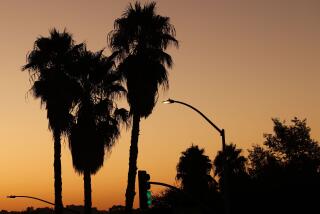L.A. Bakes at Torrid 105, and It Won’t Quit
- Share via
The desert maintained its arid reign over Southern California on Wednesday, setting another string of record-breaking temperatures and threatening to linger through the weekend.
Temperatures rose swiftly as the day progressed, reaching 105 by 5 p.m. at the Civic Center--annihilating the previous record high of 90 degrees for the day. At one point, the thermometer jumped two degrees within the span of a brief morning radio weathercast. The heat seemingly bullied everything in its path, from car engines to hairdos.
At the Charles Ross Hair Design School in West Los Angeles, the few customers who braved the blistering heat to keep appointments arrived with weather-induced emergencies. They came with their flips flopped, with do’s that didn’t and sideburns that did, power bobs that lost their juice and permanents well on their way to becoming temporary.
‘On Their Own’
“Their hair designs are wilted,” said William Towers, an instructor at the school. “When they start to sweat, the sweat relaxes the hairdos and they collapse. . . . We can fix them up in here, but when they get outside, they’re on their own.”
Forecasters expected the heat wave to roll on through the weekend. Some 100-degree marks might be broken in inland regions as late as Sunday, said Rick Dittmann, a meteorologist with WeatherData Inc. which provides forecasts for The Times.
In addition to the 105-degree record posted downtown, the thermometer reached a searing 109 in Ontario, making it the hottest spot in the nation, 105 in Long Beach and 104 in Santa Ana, Monrovia and Palm Springs.
Dittmann said that the onslaught of summer-like temperatures might seem an aberration, but is not totally unexpected. The season for Santa Ana winds, which blow desert heat toward the coast, usually lasts from September through April, Dittmann said, and “the later in the season they occur, the hotter the temperatures you get.”
As of late Wednesday, a strong high-pressure system in the upper atmosphere was stalled over the Pacific Northwest, Dittmann said. That system, combined with a lower-level high-pressure system over the Great Basin states of Idaho, Nevada and Utah, was forcing warm air--the Santa Anas--to flow from inland out toward a trough of lower pressure over the Pacific Ocean.
Southern California Edison Co. officials said power usage on Wednesday quickly eclipsed a record set only the day before. On Tuesday, 12,633 megawatts were used, setting a new mark for an April day. But by 4 p.m. Wednesday, usage had passed 14,282 megawatts. Edison’s all-time high is 15,987 megawatts, set on a 110-degree day in September, 1988.
“It’s all for air conditioning,” said Don Bailey, regional affairs manager for the company. “Everybody’s trying to keep cool.”
But when Southern Californians left their comfortable homes and offices, they were at the mercy of the sun. It was either cope or sweat.
County lifeguards estimated that more than 200,000 people fled to the beaches. But in some places, the water was as treacherous as the atmosphere. Riptides forced lifeguards to make more than 50 rescues off South Bay beaches, officials said.
Farther inland, Carmen Benalcazor and Gelma Castillo relied on a time-honored, Old World method as they went window-shopping on Fairfax Avenue. The two Ecuadorean women walked hunched beneath a bamboo parasol to shield their fair skin from the sun’s rays.
“Oh my! It feels like an oven, like Las Vegas,” Benalcazor said. “If I didn’t have the umbrella I would boil away, no?”
Yes.
Across the street, Bernard Varedi had only shadows to shield him from the sun. The owner of Bernard’s Antiques and Decorative Accessories, Varedi had to sit outside the store--as he does every day--to watch for robbers.
Varedi coped by setting his chair in the shadows cast by the merchandise he had set up outside the store’s door--a thicket of brass lamps and candelabra, stuffed ducks, a moose head and zebra skins.
“What can I do?” he asked. “The heat is no good, but I have to watch.”
A group of Department of Water and Power crewmen, preparing to go underground to work on a 34,500-volt power cable in a manhole under Main Street, faced furnace-like temperatures that soar as high as 140 degrees on a day like Wednesday.
“There’s not a whole lot you can do, except stay in the shade and drink lots of fluids,” said Richard Boyd, 34, an electrician. “But if you are working down in a hole and it gets real hot, you can pour cold water from a jug full of ice over your wrists.”
Boyd compared the method to running cool water through a radiator. “It cools the blood flowing through your body,” he said.
Elsewhere in downtown, Carla Holland was braced for a blistering ordeal. She is head cook and driver of a catering truck that was to service a film crew.
“We’re cooking Italian food for 100 people today,” she said, “and that means pasta, and that means steam. It’ll be about 140 degrees in here when we get the steam tables, grills and ovens going.”
Radiators and other engine parts gave out all over the area. On a northbound stretch of the Harbor Freeway, dozens of cars sat frozen behind an overheated Datsun stalled in the fast lane.
And in a gas station in Vernon, attendant Rene Moreno was approaching scalding-hot engine parts with caution and a wet rag. He had already serviced three overheated cars in the morning and turned his attention to a fourth.
“You got to work around the hot parts,” Moreno said as he doused a smoking car engine with water. “It’s great for business, but you got to be real, real careful.”
Times staff writers Bill Billiter, Eric Malnic and Louis Sahagun contributed to this story.
More to Read
Sign up for Essential California
The most important California stories and recommendations in your inbox every morning.
You may occasionally receive promotional content from the Los Angeles Times.













